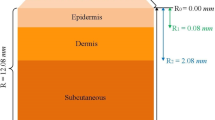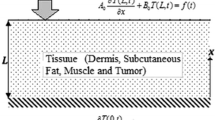Abstract
In this paper, multi-layer skin burn injuries are studied using the DPL bioheat model when skin surface is subjected to different non-Fourier boundary conditions. A skin made of three layers known as epidermis, dermis, and subcutaneous layer. These layers assumed to be homogeneous and each layer studied separately. The metabolic heat varies linearly with temperature. The diffusion and evaporation of water in the multi-layer of skin increases heat loss in the skin layer. To solve the BVP of hyperbolic PDE, the FELWG method has been used. The whole analysis presented in a non-dimensional form and the results are shown graphically. In a particular case, the result obtained is compared with the exact solution and is in good agreement. The effects of relaxation time, layer thickness, different temperature, and non-Fourier boundary condition are analyzed at the temperature of the tissue related to the burning of the skin, and the three layers are discussed in detail.

Similar content being viewed by others
Change history
11 September 2020
A Correction to this paper has been published: https://doi.org/10.1007/s10973-020-10197-w
Abbreviations
- \(c_{\uprho}\) :
-
Specific heat/J kg\(^{-1}\,^{\circ }\)C\(^{-1}\)
- k :
-
Thermal conductivity/W m\(^{-1}\,^{\circ }\)C\(^{-1}\)
- t :
-
Time/s
- T :
-
Temperature/\(^{\circ }\)C
- \(D_{f}\) :
-
Coefficient of water diffusion in tissue/m\(^2~\text {s}^{-1}\)
- \(M_{\mathrm{W}}\) :
-
The molar mass of water/18 g mol\(^{-1}\)
- RH :
-
Relative humidity/%
- P W :
-
Vapor pressure of water/Pa
- r :
-
Space coordinate/m
- ΔH vap :
-
Enthalpy of water vaporization/2408 J kg\(^{-1}\)
- Δm :
-
Water vaporization rate from the skin surface/g m\(^{-2}~\text {s}^{-1}\)
- \(\Delta {r}\) :
-
Body core distance from current tissue position/m
- \(\delta c\) :
-
The average distance of the momentum boundary layer/m
- \(\rho \) :
-
Density of skin/kg m\(^{-3}\)
- \(R_{\mathrm{a}}\) :
-
Universal gas constant/8.314 J mol\(^{-1}\,^{\circ }\)C\(^{-1}\)
- \(\tau _{\mathrm{q}}\) :
-
Phase lag of heat flux/s
- \(\tau _{\mathrm{t}}\) :
-
Phase lag due to temperature gradient/s
- \(T_{\mathrm{w}}\) :
-
Wall temperature at the boundary/\(^{\circ }\)C
- H :
-
Coefficient of reference heat transfer/W m\(^{-2}\,^{\circ }\)C\(^{-1}\)
- \(q_{\mathrm{w}}\) :
-
Reference heat flux/W m\(^{-2}\)
- \(T_\mathrm{s}\) :
-
Ambient temperature/\(^{\circ }\)C
- \(Q_\mathrm{v}\) :
-
Evaporation of water
- \(Q_\mathrm{d}\) :
-
Diffusion of water
- b :
-
Blood
- c :
-
Core
- a :
-
Air
- f :
-
Diffusion of water
- m :
-
Metabolic production
- s :
-
Surface of skin
- v :
-
Vaporization
- W:
-
Water
- \(F_{\mathrm{o}}\) :
-
Non-dimensional time
- x :
-
Non-dimensional space coordinate
- \(K_{\mathrm{i}}\) :
-
Kirchhoff number
- \(B_{\mathrm{i}}\) :
-
Biot number
- \(F_{\mathrm{ot}}\) :
-
Non-dimensional phase lag due to temperature gradient
- \(F_{\mathrm{oq}}\) :
-
Non-dimensional phase lag of heat flux
- \(P_{\mathrm{mo}}\) :
-
Non-dimensional coefficient of metabolic heat source
- \(P_{\mathrm{f}}\) :
-
Non-dimensional coefficient of blood perfusion
- \(\theta \) :
-
Non-dimensional tissue temperature
- \(\theta _\mathrm{s}\) :
-
Non-dimensional fluid temperature
- \(\theta _{\mathrm{w}}\) :
-
Non-dimensional wall temperature of the tissue
- \(\theta _{\mathrm{b}}\) :
-
Non-dimensional blood temperature
References
Pennes HH. Analysis of tissue and arterial blood temperature in the resting human forearm. J Appl Physiol. 1948;1:93–122.
Weinbaum S, Jiji LM. A new simplified bioheat equation for the effect of blood flow on local average tissue temperature. ASME J Biomech Eng. 1985;107:131–9.
Nakayama A, Kuwahara F. A general bioheat transfer model based on the theory of porous media. Int J Heat Mass Transf. 2008;51:3190–9.
Shen WS, Zhang J, Yang FQ. Skin thermal injury prediction with strain energy. Int J Nonlinear Sci Numer Simul. 2005;6:317–28.
Duncan JM, David CE, Richard A. Dynamic simulations of tissue welding. Proc SPIE. 1996;2671:234–42.
Ming F, Weng W, Yuan H. Numerical simulation of the effects of blood perfusion, water diffusion, and vaporization on the skin temperature and burn injuries. Numer Heat Transf Part A. 2014;65:1187–203.
Ming F, Chen W, Weng W, Yuan M, Luo N, Xu X. Prediction of thermal skin burn based on the combined mathematical model of the skin and clothing. J Textile Inst. 2018;109(12):1606–12.
Peng J, Tian Y. A surface heat disturbance method for measuring local tissue blood perfusion rate. J Therm Sci. 1996;5(1):28–33.
Chen B, Zhang Y, Li D. Numerical investigation of the thermal response to skin tissue during laser lipolysis. J Therm Sci. 2018;27(5):470–8.
Gupta PK, Singh J, Rai KN. Numerical simulation for heat transfer in tissues during thermal therapy. J Therm Biol. 2010;35(6):295–301.
Gupta PK, Singh J, Rai KN. A numerical study on heat transfer in tissues during hyperthermia. Math Comput Model. 2013;57:1018–37.
Cattaneo C. A form of heat conduction equation which eliminates the paradox of instantaneous propagation. C R Acad Sci. 1958;247:431–3.
Vernotte P. Les paradoxes de la theorie continue de I’equation de la chaleur. C R Acad Sci. 1958;246:3154–5.
Liu KC. Thermal propagation analysis for living tissue with surface heating. Int J Therm Sci. 2008;47:507–13.
Kumar D, Kumar P, Rai KN. Numerical study on non-Fourier bio heat transfer during thermal ablation, vol. 127. Amsterdam: Elservier; 2015. p. 1300–7.
Upadhyay S, Rai KN. Finite element Legendre wavelet Galerkin approach in investigation of non-Fourier’s and non-Ficks’s effects on heat and mass transfer during drying of foods. Comput Therm Sci Int J. 2018;10:493–519.
Bhattacharyya A, Seth GS, Kumar R, Chamkha AJ. Simulation Cattaneo–Christov heat flux on the flow of single and multi-walled carbon nanotubes between two stretchable coaxial rotating disks. J Therm Anal Calorim. 2020;139:1655–70.
Tzou DY. A unified field approach for heat conduction from macro-to microscales. J Heat Transf. 1995;117(1):8–16.
Tzou DY. Macro- to-microscale heat transfer: the lagging behavior. Washington DC: Taylor and Francis; 1996.
Zhang Y. Generalized dual-phase lag bioheat equations based on nonequilibrium heat transfer in living biological tissues. Int J Heat Mass Transf. 2009;52:4829–34.
Kumar P, Kumar D, Rai KN. A numerical study on dual-phase-lag model of bioheat transfer during hyperthermia treatment. J Therm Biol. 2015;49:98–105.
Kumar P, Kumar D, Rai KN. Numerical simulation of dual-phase-lag bioheat transfer model during thermal therapy. Math Biosci. 2016;281:82–91.
Odibat Z, Kumar S. A robust computational algorithm of homotopy asymptotic method for solving systems of fractional differential equations. J Comput Nonlinear Dynam. 2019;14(8):081004.
Ajou AEl, Oqielat MN, Zhour ZA, Kumar S, Momani S. Solitary solutions for time-fractional nonlinear dispersive PDEs in the sense of conformable fractional derivative. Chaos. 2019;29:093102.
Emile F, Doungmo G, Kumar S, Mugisha SB. Similarities in a fifth-order evolution equation with and with no singular kernel. Chaos Solitons Fractals. 2020;130:109467.
Kumar S, Kumar A, Momani S, Aldhaifallah M, Nisar KS. Numerical solutions of nonlinear fractional model arising in the appearance of the strip patterns in two-dimensional systems. Adv Differ Equ. 2019;2019:413.
Sharma B, Kumar S, Cattani C, Baleanu D. Nonlinear dynamics of Cattaneo–Christov heat flux model for third-grade power-law fluid. J Comput Nonlinear Dyn. 2019;1131.
Yanying X, Chao L, Ruiqing S, Zhi W, Qingsheng W. Experimental investigation of thermal properties and fire behavior of carbon/epoxy laminate and its foam core sandwich composite. J Therm Anal Calorim. 2019;136:1237–47.
Kleilton OS, Rossemberg CB, Josué SB, André GBJ, Wladymyr JBS, Sandra MCB, Rodrigo JO, Marcus VLF. Thermal, chemical, biological and mechanical properties of chitosan films with powder of eggshell membrane for biomedical applications. J Therm Anal Calorim. 2019;136:725–35.
Henze M, Bogdanic L, Muehlbauer K, Schnieder M. Effect of the Biot number on metal temperature of thermal-barrier-coated turbine parts-real engine measurements. J Turbomach. 2013;135:031029.
Khalid MZ, Zubair M, Ali M. An analytical method for the solution of two phase Stefan problem in cylindrical geometry. Appl Math Comput. 2019;342:295–308.
Szafer A, Zhong JH, Gore JC. Theoretical-model for water diffusion in tissues. Magn Reson Med. 1995;33:697–712.
Jiang SC, Ma N, Li HJ, Zhang XX. Effects of thermal properties and geometrical dimensions on skin burn injuries. Burns. 2002;28:713–7.
Ng EYK, Chua LT. Prediction of skin burn injury, part 2: parametric and sensitivity analysis. P I Mech Eng H. 2002;216:171–83.
Johnson NN, Abraham JP, Helgeson ZI, Minkowycz WJ, Sparrow EM. An archive of skin-layer thicknesses and properties and calculations of scald burns with comparisons to experimental observations. J Therm Sci Eng Appl. 2011;3:1–9.
Henriques FC, Moritz AR. Studies of thermal injuries I: the conduction of heat to and through skin and the temperatures attained therein, a theoretical and experimental investigation. Am J Pathol. 1947;23:531–49.
Stoll AM, Chianta MA. Method and rating system for evaluation of thermal protection. Aerospace Med. 1969;40:1232–7.
Weaver JA, Stoll AM. Mathematical model of skin exposed to thermal radiation. Aerosp Med. 1969;40:24–30.
Scheid F. Schaum’s outline of theory and problems: numerical analysis. 2nd ed. New York: McGraW-Hill; 1989.
Razzaghi M, Yousefi S. The Legendre wavelets operational matrix of integration. Int J Syst Sci. 2001;32(4):495–502.
Don E. Mathematica Second edition, Schaum’s outline’s Series, ISBN: 978-0-07-160829-9.
Pratap R. Getting started with matlab a quick introduction for scientists and engineers. New York: Oxford University Press; 2010.
Acknowledgements
First author would like to thanks the CSIR, New Delhi, India, for the financial support under the JRF (09/013(0931)/2020-EMR-I) scheme and also to the Department of Mathematics (Institute of Science), Banaras Hindu University (BHU), Varanasi (U.P), India, for providing necessary facilities. We thank all anonymous reviewers for spending valuable time to give valuable comments so that our manuscript is improved in the present form.
Author information
Authors and Affiliations
Corresponding author
Additional information
Publisher's Note
Springer Nature remains neutral with regard to jurisdictional claims in published maps and institutional affiliations.
In the original publication, few equations and figure captions were published incorrectly. The original version is corrected.
Appendix
Appendix
Second kind non-Fourier boundary condition
From Eq. (23), we have found the second kind non-Fourier boundary condition, i.e.,
Taking the Laplace transform of Eq. (63), we obtained
Using initial condition \(\theta (x,0)=0\) in Eq. (64), we get
Inverse Laplace transform of Eq. (67) is
Third kind non-Fourier boundary condition
From Eq. (23), we have found third kind non-Fourier boundary condition, i.e.,
Taking the Laplace transform of Eq. (70), we obtained
Using initial condition \(\theta (x,0)=0\) in Eq. (71), we get
Inverse Laplace transform of Eq. (74) is
Non-Fourier symmetric condition
From Eq. (27), we have found non-Fourier symmetric condition, i.e.,
Taking the Laplace transform of Eq. (76), we obtained
Using initial condition \(\theta (x,0)=0\) in Eq. (77), we get
Inverse Laplace transform of Eq. (80) is
Rights and permissions
About this article
Cite this article
Chaudhary, R.K., Rai, K.N. & Singh, J. A study for multi-layer skin burn injuries based on DPL bioheat model. J Therm Anal Calorim 146, 1171–1189 (2021). https://doi.org/10.1007/s10973-020-09967-3
Received:
Accepted:
Published:
Issue Date:
DOI: https://doi.org/10.1007/s10973-020-09967-3





































